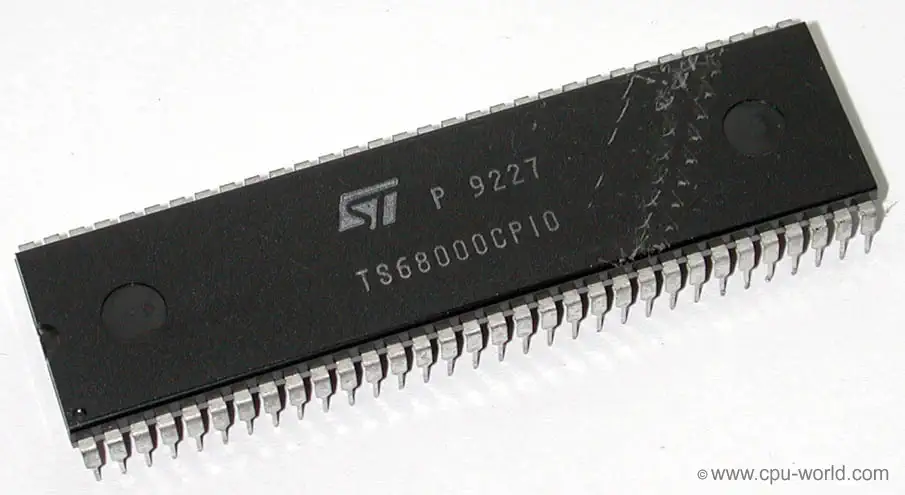
The Amiga 500 Plus
In 1987, Commodore introduced the Amiga 500, or simply the A500. The 500 Plus was a revised version of the A500 and featured minor changes to the motherboard to make the manufacturing process cheaper. It also introduced new versions of Kickstart and Workbench, and had some improvements in some of Amiga's custom chips. RAM was upgraded to 1MByte, with a maximum of 10MByte possible.
The Amiga architecture is built around Motorola's 68000 processor. The RAM was devided into Chip RAM and Fast RAM. The Chip RAM was accessible by the Video and Sound Chip, and the Fast RAM was accessible by the CPU.
Graphics Capabilities, provided by the Denise Sound Chip.
- 320x200 in 32 colors (320x256 on PAL versions)
- 640x400 in 16 colors (640x512 on PAL versions)
- Planar graphics with up to five bit planes.
- Colors come from a 4096 color palette
- Extra half-brite mode for 32 additional colors at half brightness
- HAM (Hold And Modify) mode allowing 4096 colors simultaneous
Amiga had 8 hardware sprites, each is 16 pixels wide, by unlimited height, in 4 colours (3+transparent)
- Sprites 1&2 take their palette from Colours 16,17,18,19 (16 is ignored.. transparent)
- Sprites 3&4 take their palette from Colours 20,21,22,23 (20 is ignored.. transparent)
- Sprites 5&6 take their palette from Colours 24,25,26,27 (24 is ignored.. transparent)
- Sprites 7&8 take their palette from Colours 28,29,30,31 (16 is ignored.. transparent)
Motorola 68000 CPU Family
The Motorola 68000 is a 16/32-bit microprocessor that was first released in 1979. It was widely used in computers and other electronic devices during the 1980s and early 1990s. The 68000 was known for its advanced architecture, which included a 32-bit internal bus and a 24-bit address bus, allowing it to access up to 16 megabytes of memory. This made it more powerful than many other processors of its time, such as the Intel 8086 and Zilog Z80. It was also designed to be highly modular and expandable, with a large number of on-chip and off-chip peripherals.
Some of the most famous and successful computers that used the 68000 was the Commodore Amiga and the Atari ST, both of which were popular in the home and personal computer markets. Additionally, it was also used in workstations, such as the Sun 3 and Apollo DN3000, and in a wide variety of embedded systems and industrial control systems. The 68000 was also used in the Macintosh, the first model of the Macintosh was powered by a Motorola 68000 CPU. The processor was eventually succeeded by the 68020 and 68030, which offered improved performance and additional features.
The 68000 has a 32-bit instruction set, with 32-bit registers and a 16-bit internal data bus. The address bus is 24-bit and does not use memory segmentation, making it easier to address memory. There are three ALU's (Arithmetic Logic Unit), two for calculating addresses, and one for data, and the chip has a 16-bit external address bus.
The 68000 architecture was expanded with 32-bit ALUs, and caches. Here is a list with some 680x0 versions and their major improvements:
- 68010 - Virtual memory support
- 68020 - 32-bit ALU & Instruction Cache
- 68030 - On-Chip MMU, 2x 256 byte cache
- 68040 - 2x 4K Cache, 6 stage pipeline, FPU
- 68LC040 - No Floating Point Unit (FPU)
- 68060 - 2x 8K Cache, 10 stage pipelinet

Source: WikiPedia - Motorola 6800
Source: WikiPedia - 68000 Series
RAM max: 8MB Sound Chip Paula - 4 DMA-driven 8-bit PCM channels Sound 4x8-bit channels @28 kHz stereo Display Chip Denise Display 320x200 in 4096 colors
640x200 in 16 colors
1280x200 in 4 colors
Vertical resolution could be doubled using interlacing. Best Color 4096 colors Best Graphics 1280x512 in 4 colors Sprites 8 16pixel wide/scanline 3 colors System OS AmigaOS 2.04 Storage Internal 3.5" Floppy Disk Drive.


